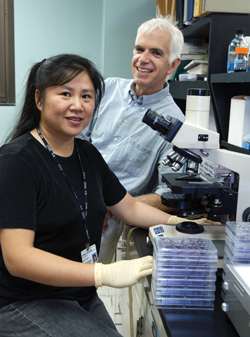
Don Rubin,M.D., and Jinsong Sheng, M.D., in Rubin’s lab.
photo by Anne Rayner
Single protein target for many viral diseases: study
HIV, measles, Ebola and Marburg — four seemingly disparate viral diseases — may someday be thwarted by a single antiviral therapy, according to a recent collaborative study involving researchers at Vanderbilt University Medical Center, the University of Georgia and the Centers for Disease Control and Prevention.
In the September issue of the Journal of Virology, Donald Rubin, M.D., professor of Medicine and Microbiology and Immunology, and colleagues, report that blocking Rab9, a host protein that helps transport viral particles out of the host cell, inhibits the ability of these four viruses to reproduce and infect other cells. The findings suggest that targeting our own genes and proteins may provide an antiviral strategy that viruses cannot easily overcome.
Viruses are the ultimate freeloaders. They slink into cells and commandeer cellular machinery to help them reproduce and disperse to new host cells. Most antiviral therapies are targeted to the viral particles themselves — viral genes or proteins embedded in their outer coating. But viruses are quick to adapt to attempts to pharmaceutically cripple them. They can rapidly mutate and develop resistance to almost any antiviral compound.
However, disabling the host factors that viruses use to replicate and spread might be a hurdle they can't jump. By focusing on the host instead of the virus itself, Rubin hoped to identify new ways to combat viral diseases.
“What I really want to do is to understand the 'cell' side of viral disease,” said Rubin, who is also a researcher for the Nashville Veterans Administration Medical Center.
To identify genes required for viral replication but not for host cell survival, Rubin and colleagues randomly inserted short pieces of nonfunctional DNA into the genomes of cultured host cells. These little chunks of DNA effectively turn individual genes 'off.' By mutating a different gene in each cell, the researchers determined which genes were necessary for the cell to survive.
Then, Rubin and colleagues exposed the surviving cells to viruses that usually kill the cell. If a cell survived the viral assault, then the disrupted gene was required for the virus to grow.
Using this method, the researchers identified a cellular protein called Rab9 as a host factor required for viral replication. Rab9 is normally involved in transporting newly made proteins (and newly formed virus particles) out of the host cell. Disrupting Rab9 prevented the replication of four different viruses — Marburg, Ebola, HIV-1 and measles viruses.
The four viruses are enveloped, meaning they take part of the host cell's plasma membrane and wrap themselves in it as they exit the cell. Reovirus, a nonenveloped virus, was not inhibited by blocking Rab9.
“Here's a group of viruses that differ from one another in terms of the disease they cause and modes of transmission, but all have found a similar exit pathway (from the cell),” Rubin said. “We believe that interfering with the Rab9 pathway interferes with the ability of the virus to be released from the cell, thereby dramatically decreasing the infectivity of the virus.”
But since transport of proteins out of the cell is an important cellular function, blocking Rab9 may have significant side effects. However, there are humans who live without Rab9, Rubin explained. Although they have metabolic problems, they are generally able to control their condition with diet and medication.
“You probably wouldn't want to be born with a total defect in this gene, but if you think of disrupting (Rab9) for a short period of time, the problems would be somewhat less severe.”
Temporarily blocking one pathway would be unlikely to harm us, Rubin said, because our cells have backup systems that can compensate.
“What exists are proteins that may be subtly different from each other providing some redundancy of pathways. They may not be as efficient as the original pathway, but they have evolved as a backup utility so that if the first pathway is not there, the host cell doesn't die.”
But because these viruses depend heavily on this exit pathway, they would probably not be able to find another route out of the cell. This suggests that Rab9 and other components of this exit pathway might be attractive targets for antiviral therapeutics against diverse types of viruses.
This research was supported by the National Institutes of Health, Hudson-Alpha Institute for Biotechnology and Avatar BioSc Inc.













